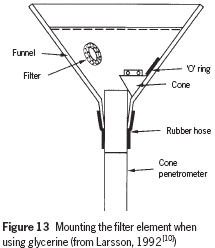Chapter 3
Piezocone
Saturation of the cone penetrometer
| SATURATION OF THE CONE PENETROMETER 3.2 The pore pressure meter is normally a pressure transducer of the membrane type. The sensor shows insignificant deformation during loading. It communicates with a porous filter on the surface of the cone penetrometer via a liquid chamber. The filter element and other parts of the pore pressure system are saturated with a liquid before field use. This saturation should be maintained until the cone penetrometer reaches the groundwater surface or saturated soil. De-aired, distilled water can be used in saturated soils. When performing dissipation tests in unsaturated soils, dry crust and dilative soils (eg dense sands), the filter should be saturated with de-aired glycerine, silicone oil or similar which makes it easier to maintain saturation throughout the test. It is good practice to cover the filter element with a rubber membrane, which will burst when the penetrometer comes into contact with the soil. Porous filters should have a pore size between 2 and 20 μm corresponding to permeability between 10–4 and 10–5 m/sec. The following types of material have been used with good performance in soft, normally consolidated clay, sintered stainless steel or bronze, carborundum, ceramics, porous PVC and HDPE. The cone penetrometer is designed in such a way that it is easy to replace the filter and that the liquid chamber is easy to saturate. In general, filter elements are saturated in the laboratory and kept saturated in airtight containers until assembly in the field. One commonly used procedure to assemble and saturate the piezocone in the field, when using glycerine or silicone oil, is to use a plastic funnel (Figure 13). |
| The cone penetrometer is turned upside down and the cone removed. The funnel is mounted and slowly filled with glycerine or silicone oil. Using a plastic syringe and hypodermic needle, the cavities in the penetrometer are saturated. The filter is carefully transferred from its container to the funnel and all parts are assembled while submerged in the liquid. |  | |
